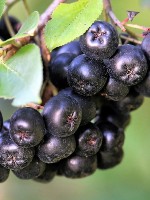Mon-Fri 9am - 5pm Mountain time
Viking Aronia Berry vs Grouseberry
Aronia melanocarpa Viking
Vaccinium scoparium
NOT AVAILABLE THIS SEASON - MIGHT RETURN
CUSTOM GROW
Viking Aronia Berry is easy to grow, with black berries that are high in antioxidants. The Viking variety is much more productive than the non cultivar Aronia Berry. The berries can be eaten fresh but are found to be tart and bitter. They are more often used in baking, jams, juices, and wine. They have small, white flowers with a hint of pink that grow evenly on the shrub. The summer foliage turns a very attractive red in the fall.
The Viking Aronia Berry is a self-pollinating plant. Because of its uniformity and high yield, the Viking Aronia Berry is a popular cultivar.
Grouseberry is a native, low-growing deciduous shrub known for its edible red berries. In early summer, it produces small, urn-shaped flowers ranging from white to pink that attract bees and other pollinators. The berries provide an important food source for many types of wildlife, including game birds such as grouse, which gives the plant its common name. People can also enjoy the berries fresh or in baked goods, though they can be difficult to harvest in large quantities.
Spreading by rhizomes, Grouseberry forms dense, broom-like mats that help stabilize soil and prevent erosion, while also providing cover for ground-nesting wildlife. It is commonly found beneath conifers in open forests, subalpine meadows, and occasionally on rocky slopes in mountainous regions. It is well-suited for naturalization, ecological restoration, and soil stabilization projects.

